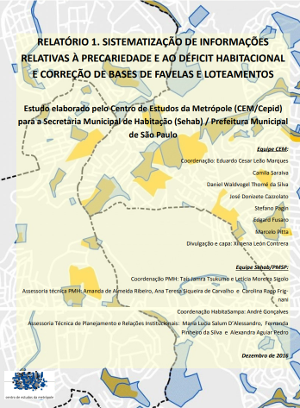Slums and irregular settlements in the Municipality of São Paulo
Data from 2010 shows that 11% of the population of São Paulo lives in slums
The work, done in 2016, carried out the quantification and estimation of the residents of slums (favelas) and irregular subdivisions of São Paulo from 2000 to 2010 in the Municipality of São Paulo (MSP). It was generally detected that during this period social and urban conditions improved, although access to sewage networks is still the most precarious indicator. Despite the improvement, there are still large inequalities in access to services between the favelas and the city as a whole, including the few existing quality indicators such as access to the electricity network with individual meter and collection of garbage by door-to-door.
The study, coordinated by researcher Eduardo Cesar Marques from CEM/CEPID for Sehab/PMSP, was accomplished in two phases: 1) correctness and repair of existing cartographies of slums and settlements in order to enable the production of statistics (without cadastral purposes), and 2) estimates of households (and people) in favelas and clandestine and irregular settlements of low income (average income of the person responsible for less than 3 minimum wage) and social characterization of the residents and their social conditions.
Given these conditions, typologies of slums and subdivisions were produced, generating four types of favelas and two types of slums. In the end, the study produced population projections for the years 2020, 2024, 2028 and 2032.
Internal heterogeneity was verified in the favelas, however: five groups with different characteristics were separated. Among them, the first four have good and great conditions, but a group of 84 favelas have very poor conditions, especially infrastructure.
Regarding settlements, 1,719,473 people and 605,707 households were found in 2010. The social and urban conditions are intermediate between the favelas and the city. Two types of settlements were found considering these conditions, the first one with almost complete infrastructure and the second with lots with precarious access to exhaustion (with 244 allotments, in a universe of 1,559).
To access, please go to the Database area [Include a link to the Database area here] (must complete registration) and Transference Studies area.


TEAM
CEM/Cepid:
Coordenação: Eduardo Cesar Leão Marques
Camila Saraiva
Daniel Waldvogel Thomé da Silva
José Donizete Cazzolato
Stefano Pagin
Edgard Fusaro
Marcelo Pitta
Divulgação e capa: Ximena León Contrera
Sehab/PMSP:
Coordination PMH: Taís Jamra Tsukumo and Letícia Moreira Sigolo
Technical Advisory PMH: Amanda de Almeida Ribeiro, Ana Teresa Siqueira de Carvalho and Carolina Rago Frignani
Coordination HabitaSampa: André Gonçalves
Technical Advisory for Planning and Institutional Relations: Maria Lucia Salum D’Alessandro, Fernanda Pinheiro da Silva and Alexandra Aguiar Pedro
The complete survey can be downloaded freely on the CEM website, in the Database area (by registering) and Transference Area







